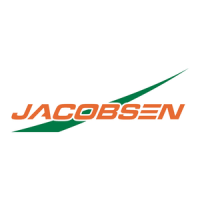
Do you have a question about the Jacobsen 321 and is the answer not in the manual?
Information on obtaining additional copies of the manual and slide sets.
Details about the Jacobsen 321 engine's design, manufacture, and applications.
History and background of the Jacobsen Manufacturing Company.
Information about the Jacobsen Product Training Center and its courses.
Defines energy and its role in work, distinguishing between potential and kinetic energy.
Defines force and its application in doing work, illustrated with examples.
Explains the concept of work in physics, relating it to force and distance.
Defines horsepower as a unit of work rate, explaining its calculation from work and time.
Defines torque as rotational force and explains its measurement in pound-feet.
Defines power as the rate of doing work and its relationship to horsepower.
Discusses the relationship between engine speed, horsepower output, and performance curves.
Explains how engine torque relates to horsepower and shows typical torque curves.
Explains power curves, torque reserve, and how they relate to engine operation.
Illustrates and describes different carburetor designs and their features.
Provides a general overview of engine operation and comparisons between engine types.
Compares the characteristics and operational differences between 2-cycle and 4-cycle engines.
Explains the theoretical basis of engine operation, including piston travel, intake, and exhaust.
Explains the function and operation of the carburetor in fuel delivery.
Discusses the importance and methods for calibrating the carburetor for optimal performance.
Details the function of the crankcase as a pump in a 2-cycle engine.
Explains the importance of the air-fuel ratio for engine performance and economy.
Explains the principles of magnetism and its role in engine components like magnetos.
Describes the function and components of the magneto ignition system.
Covers spark plug types, function, and troubleshooting for ignition issues.
Explains the components and operation of the engine's ignition system.
Details the principles of air cooling for engines and temperature management.
Explains the intake and exhaust systems, their importance for engine performance, and potential issues.
Covers the correct fuel and oil mixture for optimal engine operation and longevity.
Discusses the causes and effects of carbon build-up in the engine.
Emphasizes the importance of proper diagnosis for engine repair and customer satisfaction.
Offers general troubleshooting advice and a systematic approach to problem diagnosis.
Step-by-step instructions for starting a 2-cycle engine, including pre-start checks.
Guides on troubleshooting ignition system issues, including spark plugs and wires.
Covers troubleshooting compression problems, including checking spark plugs and cylinder condition.
Details troubleshooting steps for fuel system problems, including fuel tank and carburetor issues.
Addresses troubleshooting crankcase seal and gasket leaks that can affect engine performance.
Guides on diagnosing and clearing issues related to exhaust ports and mufflers.
Explains how to clean and maintain the air cleaner for optimal engine operation.
Covers troubleshooting engine problems related to pistons and rings, including wear and damage.
Discusses proper fuel and oil mixtures for engine maintenance and troubleshooting.
Introduces the service data section and its applicability to Jacobsen 321 engines.
Lists critical tolerances and clearances for engine components.
Details recommended engine RPM settings for various operating conditions.
Lists key specifications for the J-321 engine, including bore and stroke.
Lists special tools recommended for engine service and repair.
Provides test data for ignition coils, including resistance and gap specifications.
Lists test data for condensers, including capacitance and voltage ratings.
Outlines procedures and specifications for testing magneto components.
Describes test instruments used for engine diagnostics and their proper usage.
Outlines the process for dismantling and inspecting engine components during overhaul.
Details the removal and inspection of the governor, carburetor, and reed adapter.
Focuses on inspecting the reed adapter for proper seating and sealing.
Instructions for removing the governor and throttle linkage assembly.
Step-by-step guide for removing and inspecting the stator assembly.
Instructions for removing and inspecting the baffle and cylinder head.
Details the procedure for removing the piston and connecting rod.
Guides on disassembling the piston and connecting rod, including bearing inspection.
Instructions for installing the assembled piston and connecting rod into the cylinder.
Details the removal and installation of the engine backplate.
Instructions for removing and assembling the crankcase head.
Procedures for removing and installing the engine crankshaft.
Covers carburetor identification, nomenclature, inspection, and disassembly procedures.
Details magneto nomenclature, stator assembly inspection, and ignition timing procedures.
Offers general advice on engine preparation for storage and the importance of proper procedures.
Discusses fuel considerations for engine storage, including draining and potential deterioration.
Step-by-step instructions for draining the fuel system before storage.
Provides instructions on how to correctly order replacement parts for the engine.